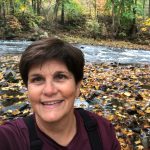Stacey Isaac Berahzer & Anna Wolf
Stacey Isaac Berahzer is a water project consultant with 18 years of experience. Through IB Environmental (ibE), she helps funders, nonprofits, utility companies, and communities fund and manage their water projects so they can make water clean and affordable. She specializes in policy related to water affordability and equity as well as stormwater and watershed management. She also has a background in Caribbean water issues. Stacey holds degrees in environmental science and in public administration. She facilitates the Georgia Funders’ Forum and chaired the board of the Institute for Georgia Environmental Leadership.
Anna Wolf joined Center for Neighborhood Technology (CNT) in 2015 and works on a variety of projects across the organization’s Water and Transportation departments. She manages research and municipal outreach for CNT’s Great Lakes Water Infrastructure Project, coordinates efforts on stormwater management components of the Elevated Chicago(link is external) initiative, and facilitates the organization’s work on water infrastructure financing. Prior to joining CNT, Anna worked at the Alliance for the Great Lakes on water resource management projects and the organization’s invasive species policy campaign. Anna has a Master of Urban Planning and Policy from University of Illinois at Chicago, and a Bachelor of Arts in International Development and Spanish from Indiana University – Bloomington.
Stacey and Anna are part of the team of talented contractors, including others from ibE and CNT as well as the team at Rudd Resources, who wrote and developed River Network’s Equitable Infrastructure Toolkit, released in June 2021. Learn more and explore the toolkit here.
What did you learn as part of this project developing the Equitable Infrastructure Toolkit?
Stacey Isaac Berahzer (SIB): I learned, to a deeper level than before, that explaining the way water infrastructure is financed is not easy. How the different financing mechanisms affect residential customer affordability is even more nuanced and community-specific.
Anna Wolf (AW): And, sometimes the best way to get a good, detailed, but still accessible resource is to allow yourself extra time to marinate in the information you want to convey. CNT worked in partnership with IB Environmental, Rudd Resources, and River Network to develop and edit the written content, and we allowed ourselves time enough to review the narrative and then review it again, ensuring that it struck the right chord with the intended audience. It took more time than initially anticipated, but I think we ended up with a stronger resource that will be useful to a variety of audiences. I’ll definitely bring this lesson along with me to future projects – allow time for review by multiple parties and levels of expertise to ensure you end up with an accessible resource.
SIB: The broad spectrum of knowledge on this topic among River Network’s members was underscored throughout this project. A tangible example came from the “sneak-peek” of the Toolkit that we did during River Rally. The breakout session that I was in as part of this Rally session had someone who had just started her job that week, as well as someone who sounded like she could have easily written the State Revolving Funds section of the Toolkit! So, producing a Toolkit that offers something to both of these members was something that we had to keep in mind throughout the project.
What was most surprising, or challenging?
SIB: A new experience for me was working so closely with a communications firm. The project team consisted of two organizations that led the content creation, and a third company that worked on the copy editing and layout. ibE led the writing on the Infrastructure Section, while CNT wrote most of the text in the Affordability Section. The sections on Utilities and Decision-Making and Influence were more of a joint effort. Rudd Resources did the layout and copy editing. The copy editor, who had no prior technical knowledge in this area, developed an impressive level of understanding of the material. The clarifying questions she posed as she reviewed our text showed a surprising mastery of the material. This was a double-edged sword: it meant we had explained the concepts well enough for her to gain a deep understanding; but it also usually meant that she could determine the next level of detail, and so there was additional text that she wanted us to provide. This is one of the reasons that the Toolkit is considerably longer than, at least I, had originally envisioned. But I also think the team, including River Network staff, came up with some interesting ways to make the material digestible through subsections on “Objectives” and “Takeaways,” as well as-call-out-boxes, quiz questions, and more than 10 real stories or “Profiles” that are sprinkled throughout the Toolkit.
AW: I came into this project ready to face the complicated nature of addressing water affordability and equitable infrastructure investment. On the surface, it seems simple enough to advocate for and achieve affordable and reliable water supply and stormwater services. Digging deeper reveals hidden complexities in how local infrastructure investment decisions are (or are not) regulated and how challenging it is to get involved in ways that affect meaningful change. Part of the challenge we faced was covering salient information in a detailed enough way to be helpful without being overwhelming. It was very rewarding to work with a team with a diversity of perspectives and skillsets to create a resource that provides information that is “in the weeds” for some readers and high level for others.
What are your greatest hopes for how this toolkit will make a difference?
AW: I think the most exciting part of the Toolkit is the Decision-Making and Influence section, in which we outline clear ways to get involved at the local, state, and federal levels. The first step, though, to getting involved, is reflecting on how water infrastructure impacts an individual’s or family’s daily life. I hope people use some of the reflection questions in this section to reframe their relationship with water and the infrastructure needed to manage it, and consider the ways in which water intersects with other issues that are front and center in our communities, like housing and economic security. I also hope that the toolkit both reveals and clarifies for advocates and individuals the complicated way in which decisions at multiple levels of governance and decision-making influence affordability outcomes. The answer to addressing affordability is not simple – it requires a multi-pronged approach and coalitions of people and organizations working at different levels to create long-lasting solutions.
SIB: Similarly, I hope that the Toolkit will cause people interested in water issues to be better equipped to talk to the staff of utilities, funding programs, and even the federal government. When advocates come to these staff with some understanding of the existing systems, and the challenges involved in their jobs, it starts the relationship off on a good note. Collaboration and cooperation are more likely. I hope that the Toolkit reduces the frustration that advocates and government staff sometimes experience with each other.
Anything else you’d like to add?
SIB: A fun fact about the project is that it ended up being an all-women team. I count thirteen women who worked on the project. (We did have one gentleman who joined us for the first couple of kick-off sessions, and a now eight month old who made cameo appearances during our Zoom meetings, based on his nap schedule, of course.) The team worked harder than we expected to, but at least it was a fun group!
AW: It is so easy to take water for granted when you haven’t dealt with a flooded basement, water quality issues, or disconnected service! We should all be working to ensure that no one faces these issues and I (and the CNT team) are so grateful to have worked with our collaborators, IB Environmental, Rudd Resources, and River Network, to create and share resources that move all of us to a more secure and clean water future.







